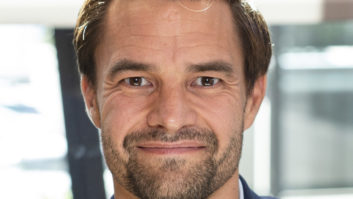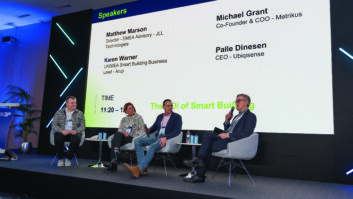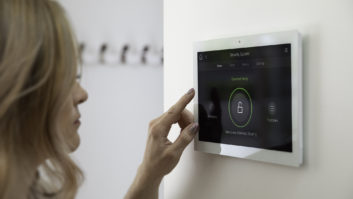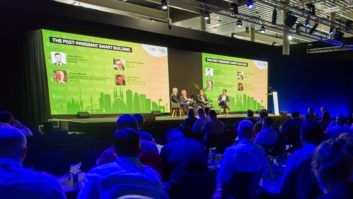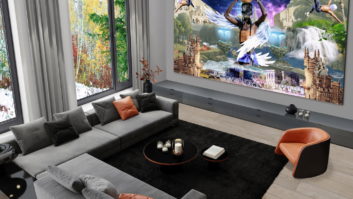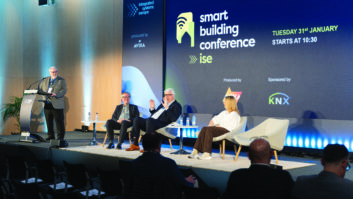As someone who has been involved in the Smart Building Conference since its inception in Amsterdam two years ago, conference chairman and content editor Bob Snyder is acutely aware of the dual function it plays: to inform the AV and electronic systems industry about how the broad construction industry functions in the smart building area, and vice versa.
“At our London conference, Siemens came out on our stage and put up a chart that showed the smart building without us,” says Snyder with a wry grin. “The problem for us as an industry is that the building industry doesn’t acknowledge us yet. Half of it is not up where it needs to be with its digital transformation. So part of the exercise with the Smart Building Conference is we’re bringing in these diverse traditional industries that are only now becoming digitally transformed and confronting them with this end piece, which is us. At the same time we’re trying to educate InfoComm and CEDIA members about what other people’s digital transformations are so we understand the opportunities.”
Snyder reports that ISE is an excellent draw for getting high-level speakers from outside the AV and electronics systems industry to come to the Amsterdam Smart Building Conference. “Once they get here, they change their opinions of us very quickly. Take the gentleman from the Smart Building Association of America who gave one of our keynotes last year. He gets to speak at 20-something smart building conferences a year, and he said ours was the best one he’s ever been to, because a lot of the others don’t address how you treat the workplace and the people within it.”
Rotating topics
The rapidly changing nature of the subject area, and its sheer size, mean that, in putting the programme together for the Amsterdam conference, Snyder has to make some important choices. “By virtue of this gigantic digital transformation, the idea of the smart building as an industry construction is changing in front of our eyes, so we’re chasing a moving target. At the same time because it’s so wide and diverse I’m rotating topics from one conference to the next, to ensure that ISE attendees get exposed to every part of the smart building industry and also ensuring that those individual industries get exposed to us.”
So for ISE 2015, the Smart Building Conference has two key focuses: on lighting, and on the Internet of Things, neither of which has been covered previously in Amsterdam. “People who came last year will find a very different programme,” observes Snyder, “just as people last year found a very different programme from the year before. With each Smart Building Conference we see new faces, we hear new opinions – we’re not giving the same lessons each time.”
In what is a highly impressive line-up of speakers, one of the outstanding names is Rogier van de Heide – “one of the top people in the world in lighting”, according to Snyder. Van de Heide is chief marketing and design officer of lighting company Zumtobel Group, but was previously chief design officer for Philips Lighting, and before that the global business leader in lighting design at Arup. He has also built a major profile as a TEDx presenter, giving speeches on lighting and architecture.
“He’s going to address the topic of why light needs smartness – the networkability of LED lighting and how it all comes together in a dramatic way for buildings.”
Another high-profile speaker from the lighting world is Mike Welch, co-founder and managing director of Network Controls, whose speciality is the global intelligent lighting market. In ‘Intelligent Lighting Control: Whose Business Is it?’, says Snyder, “he’s going to combine all the trends in lighting and networking lighting and ask who gets a shot at this and why – what types of companies can sell it? I think it’s great for the ISE audience, because it helps them to find out to what degree they can become involved – and it overlaps the commercial and residential spaces.”
Turning to the other key focus of the conference, Dipak Raval, head of smart building architecture at Cambridge Consultants, will be giving a talk on smart sensors.
“The sensors can tell you a lot of things: some detect motion, some shoot video, read temperature, detect gases and so on.
If you combine these sensors with clever algorithms, there are many possibilities to make buildings smarter than they are today. These smart sensors are effectively the engine of the Internet of Things, so it’s good to go into some depth into what can they do, where can they go.”
Snyder singles out indoor location as one important application. “Smart sensors can pinpoint where everybody is in a building: so if you have an emergency and put on the fire alarm, you can say, for example, ‘Why isn’t Henry out of the storeroom?’. When you put them into large buildings or malls they become commercially useful tools. An indoor locator can tell someone, via their smartphone, here’s exactly where you are in the mall, here’s where you want to go, and here are the services you’re going to see on the way.
“What we’re looking to hear in this session is what’s the state of the art, how fast is it moving and to what degree do we have to be influenced by it?”
The Internet of Things will also be discussed in a panel session. “This panel is going to be specifically addressing building-related issues on connected homes and smart buildings, and how integrating sensors will create a mountain of Big Data and lot of control possibilities for buildings that just haven’t existed previously. How are all the devices in the building going to interact with the building as well as with each other?”
Among the panellists will be Gilles Thonet, managing director Europe of the Zigbee Alliance, plus a representative from Greenwave, a manufacturer of smart home products.
In an unusual step for the Smart Building Conference, a speaker from one edition of the conference has been invited back to share his message in another city. Paul Fletcher, managing director of architectural consultancy through… will address the Amsterdam SBC following a barnstorming performance in London. In his session, entitled ‘Smart Building Myths: The Architect’s View’, he will argue that more can and should be done to design and create buildings for people’s real needs.
“People were ready to give him a standing ovation at the London conference – he was controversial, he was direct, he was powerful, people loved him,” enthuses Snyder.
Two tracks
As in previous Smart Building Conferences, the programme will split for parts of the day into two tracks, covering the residential and commercial markets.
One speaker whom Snyder says he is particularly pleased to have recruited is Nick Graves of Aquilla Europe, a business consultancy specialising in Apple products, the Apple market and the Apple ecosystem in Europe.
Graves will give an informed view about how Apple Home Kit – a framework in iOS 8 for communicating with and controlling connected accessories in the home – is likely to be deployed. “You can’t get Apple people up on a stage at an event like this, but Nick is an ex-Apple executive. He spent 22 years there in different senior management roles – he headed he European platform management group and his most recent job there was to create, build and manage the accessories business for the online and retail Apple stores.
“So for 22 years he was close to senior European management – that’s as close as I can bring our audience to how Apple thinks, what Apple might do, and someone who follows everything that Apple does.”
In the Commercial track, in addition to Dipak Raval’s presentation on smart sensors, renowned audio consultant Roland Hemming will present a session entitled ‘Communications in Public Spaces’. This will discuss what has to happen in smart buildings regarding public address systems, emergency announcements and safety issues under European regulations, and the role that networked audio systems have to play here.
Additionally, both the Commercial and Residential tracks will give attendees the opportunity to learn about the size of the smart building opportunity in their respective sectors, when experts present market research data.
Snyder recounts that recently he was talking to an AV journalist who did not see the significance of smart buildings to his readers. “He said, ‘Why are you asking my readers to go into heating, ventilation and plumbing?’
From my side we’re not looking to persuade AV people to do that – we’re trying to convince them that all these disparate systems are going to be connected on the same network and they’re all going to have to talk to each other. The people in charge of heating, ventilation and plumbing may end up being their boss in the building – because that industry is developing very sophisticated digital building automation systems, and they’re trying to take control of the building. They’re doing exactly what every other industry including us wants to do – they want to be the people in charge. Nobody knows who that will turn out to be, but it’s quite clear, it’s irrefutable – everything in that building is going to be on the same network.
“So I think that smart building is a very important subject for ISE visitors to get their heads around. You’re not going to come out able to run HVAC systems, but you’re going to be able to read what the future will be bringing. Stay away at your own risk!”
The Smart Building Conference takes place in the RAI Forum on Monday 9 February.
www.smartbuildingconference.com
